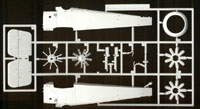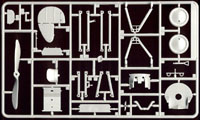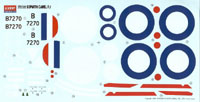From Internet Modeler
Academy 1/32 Sopwith Camel F.1
By Michael Benolkin
Oct 1, 2000 - 9:14:13 PM
Background
The Sopwith Camel is probably the first aircraft the average person with name when soliciting aircraft types from World War I. Why? It was easily the most successful British-made fighter of the war, with over 1290 kills credited to the type. 5,490 Camels were built, with some serving in Belgian and American Expeditionary Forces.
The single, most-remembered engagement from the Camel's logbook was when Canadian Captain Roy Brown encountered and attacked German ace Manfred von Richthofen. The Camel was retired from service shortly after the end of the war.
 The Kit
The Kit
This is a re-issue of Hobbycraft's 1/32 Camel kit. The kit features simple construction, complete with logical rigging steps with the included thread. The kit is flash free, but unfortunately sports mold ejector pin marks throughout the kit.
My first concern was with the wings, and the good news is that there are no ejector  pin marks on the concave undersurfaces of the wings. The few pin marks that are on the wings are on the upper surface, in areas that are easily accessible without endangering any detail.
pin marks on the concave undersurfaces of the wings. The few pin marks that are on the wings are on the upper surface, in areas that are easily accessible without endangering any detail.
While the inside of the cockpit does have ejector pin marks, and they are in areas that will be challenging to clear without too much damage of the interior, it appears that (at least my example) the marks are not very significant and could be overlooked through the small cockpit opening.
 The engine is very nicely detailed and represents all of the details of the Clerget engine. The kit also accurately represents the unique way that the rotary engines were designed and installed in aircraft - the engine rotates with the propeller! The rotation enhanced engine cooling (as they had not yet mastered aerodynamic cowls and cowl flaps) and provided more mass for a flywheel to dampen out engine misfires, etc. The downside of this approach was that spinning mass also created a great deal of torque, pulling the unwitting pilot to the right. There were a number of accidents attributed to this as pilots transitioned into the Camel.
The engine is very nicely detailed and represents all of the details of the Clerget engine. The kit also accurately represents the unique way that the rotary engines were designed and installed in aircraft - the engine rotates with the propeller! The rotation enhanced engine cooling (as they had not yet mastered aerodynamic cowls and cowl flaps) and provided more mass for a flywheel to dampen out engine misfires, etc. The downside of this approach was that spinning mass also created a great deal of torque, pulling the unwitting pilot to the right. There were a number of accidents attributed to this as pilots transitioned into the Camel.
 Markings are provided for two examples:
Markings are provided for two examples:
-
Camel F.1, B7270, 209 Sqn (flown by Captain Roy Brown)
-
Camel F.1, unknown, 43 Sqn
Conclusion
This kit is simple, nicely laid out, and despite the pin marks, will build into a nice example of WWI air superiority. This would also serve as a great training kit for rigging WWI aircraft.
The kit can be built straight out of the box for a nice project, supplemented with photo-etched details from Tom's Modelworks to achieve a 1/32 contest contender, or with some creative strip plastic and other resources for a masterpiece. In any case, find yourself some reference material to aid your project (but don't get so carried away that you never even start the project!!).
My sincere thanks to MRC for this review sample!
© Copyright 2023 by Internet Modeler
 The Kit
The Kit pin marks on the concave undersurfaces of the wings. The few pin marks that are on the wings are on the upper surface, in areas that are easily accessible without endangering any detail.
pin marks on the concave undersurfaces of the wings. The few pin marks that are on the wings are on the upper surface, in areas that are easily accessible without endangering any detail. The engine is very nicely detailed and represents all of the details of the Clerget engine. The kit also accurately represents the unique way that the rotary engines were designed and installed in aircraft - the engine rotates with the propeller! The rotation enhanced engine cooling (as they had not yet mastered aerodynamic cowls and cowl flaps) and provided more mass for a flywheel to dampen out engine misfires, etc. The downside of this approach was that spinning mass also created a great deal of torque, pulling the unwitting pilot to the right. There were a number of accidents attributed to this as pilots transitioned into the Camel.
The engine is very nicely detailed and represents all of the details of the Clerget engine. The kit also accurately represents the unique way that the rotary engines were designed and installed in aircraft - the engine rotates with the propeller! The rotation enhanced engine cooling (as they had not yet mastered aerodynamic cowls and cowl flaps) and provided more mass for a flywheel to dampen out engine misfires, etc. The downside of this approach was that spinning mass also created a great deal of torque, pulling the unwitting pilot to the right. There were a number of accidents attributed to this as pilots transitioned into the Camel. Markings are provided for two examples:
Markings are provided for two examples: